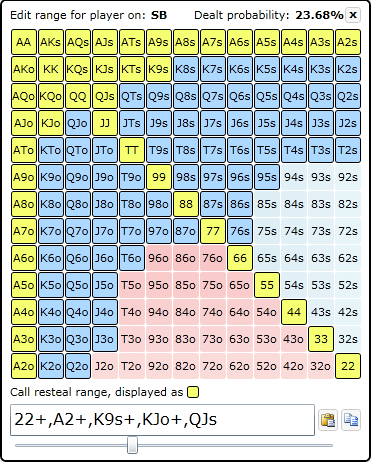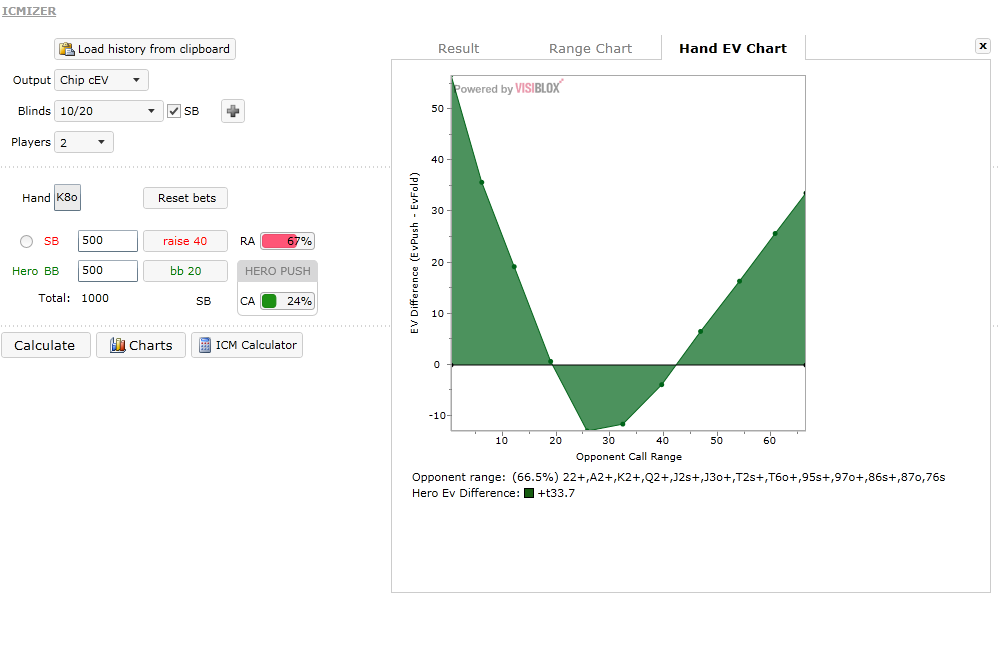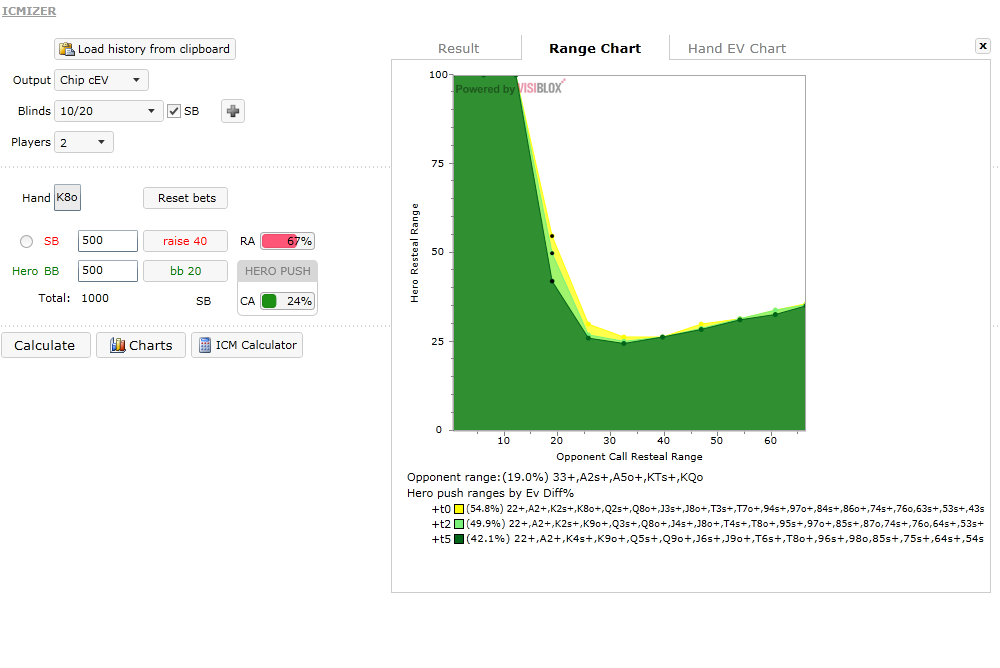Analyzing 3bet resteals in heads up sit and go
by Q.
Many players are interested in learning mathematically correct resteals in HU SNGs. This can be especially important in hyper turbo SNG. In this article I will show you how you can analyze preflop resteal spots heads up with my program ICMIZER.
One of common questions regarding resteals heads up is the following: is any ace (A2+ range) good enough for a +EV resteal against minraise at the start of hyper turbo sit and go with 25bb effective stacks and against a pretty wide opening range.
We will review this exact situation. In order to get results of analysis open the following link:
https://www.icmpoker.com/icmizer/#Eisd

In order to analyze a situation we will need to input following data points about it
- Stacks of players
- Blinds level
- Payout structure – Heads Up/ WTA (winner take all, 100% first place)
- Steal raise size, in our case we are facing a minraise of 40 chips at blind level (10/20). In order to edit raise size you need to click the button below “Raise Size” text on screenshot (which has text “raise 40” on it) and choose actual raise size in popup bet editor control.
- Steal range of player on small blind. In program it is displayed as RA 67% (raise)
- Range of calling our resteal all-in bet. Call resteal range on the picture, displayed as CA 24%(call). This range is always a subrange of raise size, so it cannot include hands which small blind doesn’t raise with. In extreme case when opponent is always playing raise-call with entire range CA range will be equal to RA range (for this case it will be also 67%)
- Number of players - 2
After we have completed the situation we just press [Calculate] button in order to get results which are displayed on the screenshot. In this grid for each possible starting hand of hero a value that is equal to (EQ push action– EQ fold action) for hero. On this screenshot it is displayed in % from total prize pool, but there are also other outputs available, in chips (chip EV) and in dollars ($), after you set the total size of prize pool for tournament. In order to change type of displayed result you need to choose it from dropdown menu Output.
ICMIZER allows quick and easy editing of raise and call ranges with mouse and by means of copying them from clipboard. On the screenshot below is a sample look at editing Call Resteal Range.

Blue background color of hands indicates that they are included in raise size, and yellow color indicates hands with which opponent will actually make the call of our resteal. In the lower part of range editor control there are buttons for copying and pasting range from clipboard. You can also select the range with CTRL+A key combination, and copying and pasting can be done with usual CTRL+C/CTRL+V combinations.
I hope that table with results speaks for itself. Green color indicates more expected value than red color. If you would like to get a whole range of hands with which resteal has say +0.3% percent of prize pool, you can change value of diff %. A matching range of all hands that are fitting the required EV difference will be displayed below (hero range). It can be selected with mouse and copied with CTRL+C combination.
As we can see in this case resteal with A2o hand is very profitable for us. But if raise range will be a little tighter, and call will be a little lighter we will have a different situation and A2o will not be a +EV resteal hand. In that case hands it will make sense to play hands like A2o differently.
Besides ability to figure out resteal expected value for all starting hero hands there are two more ways to analyze current situation. Lets say that we know the raise range of opponent, and we are thinking about restealing him with a K8o hand. We are interested in the answer on the following question: how wide does opponent have to call use in order to make the resteal profitable for us. To get the answer on this sort of question we can analyze Hand EV Chart.

In this case X axis represents call resteal range (with a maximum at whole raise size, or 67% in our case, max right X position). If on the other hand opponent is raising with 67% hands, but only calls our resteal with aces, we are in most left position on the chart. So for each potential call resteal range we can see EV of pushing for K8o hand. From current chart we can deduce that if opponent is fairly tight or a little too loose, pushing is profitable for us. If on the other hand he/she is pretty adequate and his/her call resteal range is in the middle, around half of his/her raising hands, push becomes not profitable for us. In this case we can see that push can be negative EV move with minimum EV of around -10 chips. On this screenshot chart is displayed with Output set to Chip EV, so EVs are displayed in chips. You can hover mouse over chart to see respective EV for hand against selected opponent range.
A second way to analyze situation graphically is to figure out our profitable resteal range against selected call resteal range. To get that we look at Range Chart.

On this chart X axis is the same as on previous chart, call resteal range of our opponent. Y axis now is our range matching resteal range against that, in percent of starting hands. Different colors indicate different +EV ranges, so if we decide to that we don’t need too much equity, we can obviously be lighter, and so yellow point at 0 EV will be our widest non negative EV range. We can resteal with a maximum value 100% or any two cards (ATC) when our opponent is calling us very tight. On this screenshot we can see that we can shove ATC if he/she is calling with less than 15% of starting hands. When we hove mouse over the chart we can see specific values of opponent call resteal range on X axis and respective ranges for hero, which on this chart would match 0, 2, 5 chip EV difference requirement.
Please notice that on both charts opponents raise range is fixed (it is taken from situation input and remains fixed at 67% value), and only call resteal range is changed (stepped from min to max) on X axis.
Q